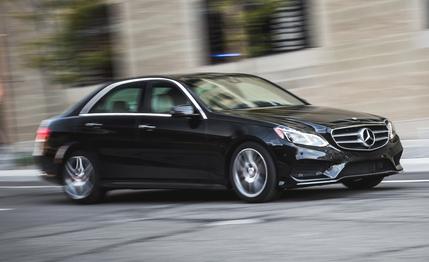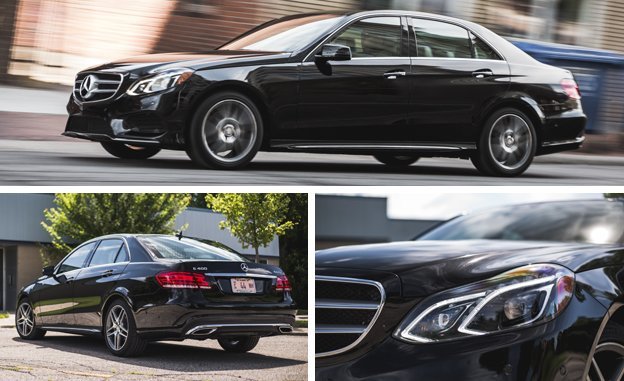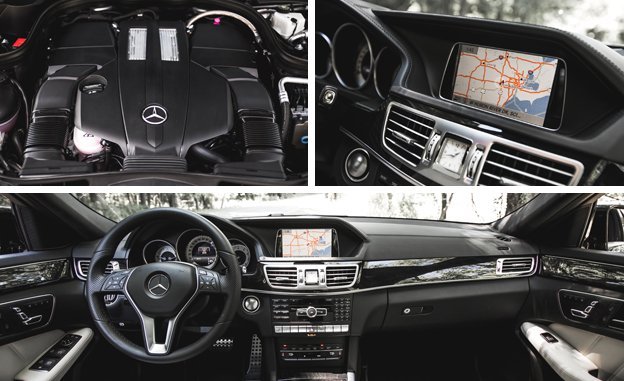
 Instrumented Test
Instrumented Test
Mercedes-Benz currently builds almost as many models off the basic E-class platform as General Mills has flavors of Cheerios. Whole grains processed into toroid toddler kibble can be had in 15 varieties at last count. Count up the sedan, wagon, cabriolet, and coupe bodies; tally engines with four-, six-, and eight cylinders; and then stir in high-performance AMG editions, and we count 14 E-class models for 2015 without even stretching to include the five CLS-badged four-door “coupes” on this chassis.
For this test, we have the newest flavor of Stuttgart’s midrange sedan, the E400 4MATIC. Consider it the Cheerios + Ancient Grains edition. Propelled by a more environmentally friendly twin-turbo 3.0-liter V-6, this 329-hp E400 replaces the E550 as the top non-AMG sedan and wagon for 2015. The E550 with its 402-hp V-8 continues in the coupe and cabriolet, where this new turbo six instead replaces last year’s base engine, the naturally aspirated 3.5-liter V-6 (it continues in E350 sedans and wagons). Performance gluttons can still opt for a stonking E63 AMG sedan with up to 577 horsepower, if they really must have a V-8 in this body style and have lines of credit to match its bulging power curve.
Giving up two pistons and 73 horsepower while the base price swells to $65,775 from the $62,325 2014 E550 4MATIC does not, on its surface, make this look like a change targeted to please the driving enthusiast or the value seeker. It does please regulatory agencies on both sides of the Atlantic, though, and EPA ratings on 4MATIC sedans improve from the E550’s 18/24 mpg city/highway to 20/28 on the new E400. Our observed fuel economy of 22 mpg bested our test of the V-8 version by 2 mpg, or 10 percent.


The predictable degradation in performance showed up at the track with a zero-to-60-mph time of 5.0 seconds, exactly a half-second slower than our E550 test. The quarter-mile in 13.6 at 104 mph is 0.6 second and 7 mph slower than before. The gap is smaller, 0.2 second, in our 30-to-50 and 50-to-70-mph passing tests. Mind you, we called out the accelerative performance of last year’s V-8 model as “more than ample.” Five-flat to 60 mph isn’t slow. But neither does it shine against competitors like the Cadillac CTS Vsport.
Its mass of 4273 pounds means the E400 4MATIC is 161 pounds lighter than the E550 but 307 heavier than the Cadillac. Opting for a rear-drive model would shave off even more—the E550 was all-wheel-drive only, which makes for tidy comparison in this test and with the Audi A6 Quattro that’s our current favorite in the segment. This car had Continental tires that the Monroney called out as a $250 special order of “high-performance” rubber. They didn’t do as well at the track in braking (164 feet from 70 mph versus 157) as the Pirelli P Zeros that came on the E550. The skidpad wasn't available when we tested the E550, but this E400 held on for 0.84 g of lateral acceleration. We noted some freeway sizzle noise from the E550's Pirellis but none from these Continentals.
Another way to look at this car’s engine transplant, one that Mercedes would probably prefer, is as the new upgrade option from the E350. From that perspective, it’s a clear step up in performance and character. One reason that the E350 ranked third in a four-way comparison with Audi, Cadillac, and BMW contenders was the “gritty” texture of the power delivery from its 302-hp 3.5-liter V-6. True, the power margin moving up to the turbo six isn’t as great as when the step was to a turbo V-8. With less displacement and twin turbochargers to muffle the noise while generating a lot more torque, the E400’s power unit comes across as more appropriately luxurious than the E350’s. Only those with time-enhanced memories of the silky inline-sixes of Mercedes’ distant past could quibble with the way this bent-six serves up the thrust, and we’d remind them to look at both the total output and the fuel efficiency the modern engine delivers.


For those seeking luxury more than excitement, it’s gratifying to drive the E400 in daily use. Like its many stablemates, the chassis feels stout and the body solid in ways that we’d feared—not without reason—that Mercedes had forgotten about after the early 1990s. The interior looks rich and the controls all work without fuss or bother. This example included optional porcelain/black nappa leather ($1370), a panoramic sunroof ($1090), and the $660 multi-adjustable driver’s seat with massage functions. We could live without the $1290 Parking Assist package, but the car was mercifully free of the more intrusive “active” blind-spot and lane-keeping equipment we’ve argued with in other Stuttgart products. The car still issues warnings, but it doesn’t try to take over for the driver with unwanted steering and braking inputs. The other big-ticket option was the $1500 Lighting package with full-LED headlamps, adaptive high-beam assist, and active curve and corner illumination. These worked great as both functional lighting and driveway bragging points.
We’d have been happier with this engine transplant if Mercedes had managed to squeeze a bit more power out of the 3.0-liter, but one must recognize this isn’t the only application for it. It also serves, for instance, as a new entry-level mill for the CLS400. Those seeking a more invigorating driving experience have plenty of alternatives even within the E-class range, so if Ancient Grains isn’t your thing, you just need to set your own priorities and browse the shelves a bit.